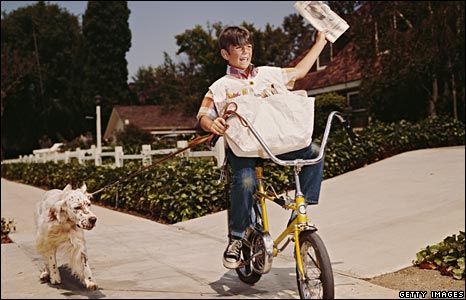Entries in Wind farm birds (29)
2/27/11 WINDKILL: How "Green" is a bird and bat killing machne? AND No matter what language you say it in, wind turbine shadow flicker is intolerable
[Note: Illustrations and photos on this post added by the BPWI Research Nerd]
WIND FARMS AND DEADLY SKIES: TURBINES ON TEXAS COAST KILLING THOUSANDS OF BIRDS AND BATS EACH YEAR
 SOURCE: San Antonio Express-News, www.mysanantonio.com
SOURCE: San Antonio Express-News, www.mysanantonio.com
February 27, 2011
By Colin McDonald,
SARITA — The 260-foot-tall wind turbines of the Kenedy Ranch stand like a steel forest along the edge of the Laguna Madre and pump out hundreds of megawatts of emission-free electricity.
The spinning blades, alongside some of the most important habitat in Texas and one of North America’s largest migratory flyways, are killing thousands of birds and bats each year.
How many isn’t publicly known because, unlike California counties, Texas and the federal government don’t require turbine operators to make public reports, according to state and federal officials.
Aside from the quantity of bird and bat deaths, a more complicated question remains unanswered as more wind turbines are put up along the Texas Coast: Have the turbines changed the ecosystem and displaced wildlife?
For the first time, Pattern Energy, which owns 118 turbines on the ranch, and Iberdrola Renewables, which owns 168, voluntarily released results of their first yearlong studies.
Pattern estimates up to 921 birds and 2,309 bats were killed between Aug. 24, 2009, and July 31; Iberdrola’s estimates: 1,812 birds and 3,087 bats for the same period.
While the bird killings match the national average, one researcher found the bat killings much higher than expected.
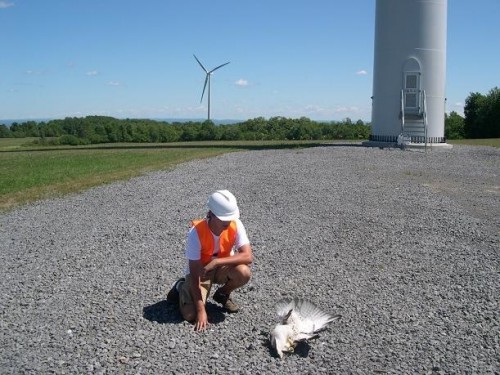 Those who opposed the wind farms are not convinced the studies are credible or conclusive.
Those who opposed the wind farms are not convinced the studies are credible or conclusive.
The work was paid for by the companies and not peer-reviewed. In their reports, biologists wrote about the challenges of collecting good data with rattlesnakes biting their search dogs and cows that would not leave. The researchers estimate scavengers removed half of the bird and bat carcasses before they could be found.
They also could not get federal permits to collect the species they did find, so many had to be marked as unknown.
After more than a year of submitting forms, the companies received a collection permit last month, said Rick Greiner of Pattern Energy.
But of the species identified, none were endangered.
“We think there is a low impact to T and E (threatened and endangered species) because we have not found any,” he said.
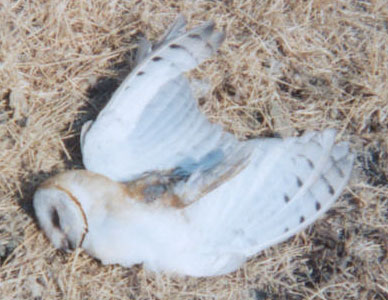
The reports state the wind farms had a bird mortality rate of three birds per megawatt, which is in the middle for the national average of one to six birds, according to the American Wind Energy Association, a trade group. A national average for bats killed per megawatt is not well-established.
In addition to average bird mortality, the companies point to the high-tech radar systems they voluntarily installed that will trigger a shutdown of the spinning turbines during fog or low visibility when a mass of birds or bats is approaching.
As of the end of 2010, a shutdown had not occurred.
“At every stage of the project’s life, Iberdrola Renewables has gone above and beyond what has been required by the state of Texas and federal government to conduct extensive studies and monitor the outcomes of our wildlife protection measures,” said Jan Johnson, a spokeswoman for Iberdrola.
More than numbers
One who disagrees the studies have been extensive is David Newstead, an environmental scientist for the Coastal Bend Bays & Estuaries Program in Corpus Christi and president of the Coastal Bend Audubon Society.
He believes mortality rates are an incomplete measurement of the effect of wind farms. The numbers do not reflect how turbines could be changing behavior of birds and bats by forcing them out of their habitat and putting them under greater stress.
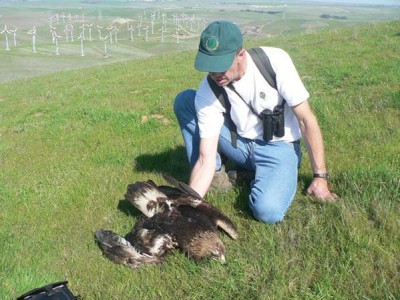 “Cumulative effects are practically never discussed by wind developers,” Newstead said. “At the end of the day, the most important numbers, for the sake of the wildlife, is how many of what species of birds and bats are being not only killed, but displaced.”
“Cumulative effects are practically never discussed by wind developers,” Newstead said. “At the end of the day, the most important numbers, for the sake of the wildlife, is how many of what species of birds and bats are being not only killed, but displaced.”
Newstead is one of most vocal challengers to the construction of wind farms along the Texas Coast and was part of an unsuccessful lawsuit to stop them, funded in large part by the King Ranch, which borders the Kenedy Ranch.
“There is no other place in North America that plays such an important role for so many species during some part of their lives,” Newstead said about the Laguna Madre and surrounding grasslands. “Collision mortality can thus affect any of more than 400 regularly occurring species.”
Newstead’s concerns for the coast only grow as more turbines are built, following the lead of the Kenedy Ranch.
Since the Kenedy turbines came online in 2009, Iberdrola has added more, and the Papalote Creek Wind Farm with 196 units was built outside Corpus Christi, according to AWEA.
When operating at capacity, the Kenedy Ranch turbines in total can generate close to 680 megawatts, or enough electricity to meet the needs of 135,000 to 170,000 homes, according to CPS Energy, which buys power from Iberdrola.
That power is produced during the day when consumer demand is the highest, and it can be delivered via uncongested transmissions lines, said CPS Energy spokeswoman Lisa Lewis, adding that effect on wildlife was not considered when it signed the contract.
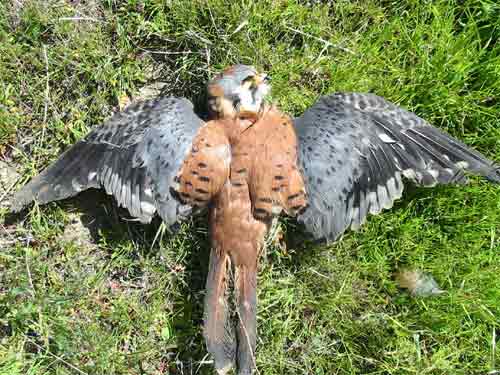
Working with wind
For now, wind companies face few consequences for killing wildlife, explained Paul Schmidt, assistant director at the Migratory Bird Program for the U.S. Fish and Wildlife Service.
While it’s against federal law to kill or harm any endangered, threatened or migratory bird species, the agency has not prosecuted any wind farm owner.
Instead, the service is working with the wind industry, scientists and conservationists to establish guidelines for how wind companies should place and operate a wind farm, Schmidt said.
A draft of those guidelines was released for comment this month.
Once the guidelines are adopted, the Fish and Wildlife Service will have a basis to decide which companies to investigate, Schmidt said.
“It’s just like you’re driving down the highway and the speed limit is 55,” he said. “You can go 60, probably 62, but at some point you are going to get caught.”
Schmidt said companies that volunteer information will avoid the scrutiny given those that do not.
Pattern and Iberdrola have regular communication with the service. But the reports they send are marked “privileged and confidential,” so they can’t be shared.
When Pattern gave its reports to the San Antonio Express-News, it called them public but then requested it preapprove anyone who saw them and that they not be posted online.
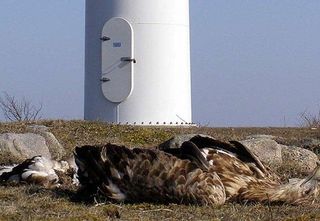 “Clearly we have a problem with transparency with the wind and wildlife issues, and I think we have a ways to go,” said Edward Arnett, director of programs at Bat Conservation International, whom Pattern approved to review its studies.
“Clearly we have a problem with transparency with the wind and wildlife issues, and I think we have a ways to go,” said Edward Arnett, director of programs at Bat Conservation International, whom Pattern approved to review its studies.
With wind farms across the country reluctant to share data openly, the understanding of the cumulative effect on wildlife and the best way to minimize it are stunted, Arnett said. This is especially true of bats.
At 150 feet long, the wind turbine blades move between 100 and 180 mph at their tip. The pressure change on the trailing edge is enough to cause internal hemorrhaging in bats, according to Bat Conservation International.
Before the Kenedy wind turbines went in, Arnett had expected low bat mortality, as there were no known concentrations of bats in the area. Since so little is known about bat movements, he is not surprised the numbers turned out to be higher.
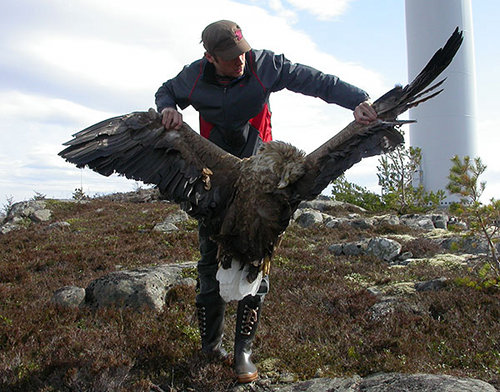 Before wind turbines were built, little was known about bat movements.
Before wind turbines were built, little was known about bat movements.
It isn’t possible to know what is and isn’t working, he said.
“Until we have the information published in a credible fashion that is publicly shared and published in journals, it is going to be unknown,” he said.
SECOND FEATURE:WIND TURBINE SHADOW FLICKER MAKES DANES MISERABLE
THIRD FEATURE
WIND TURBINE SHADOW FLICKER MAKES BADGERS MISERABLE
9/12/10 Same stories, different locations: Why are people complaining about living near wind turbines? AND How a documentary about rural town facing wind developers is opening eyes
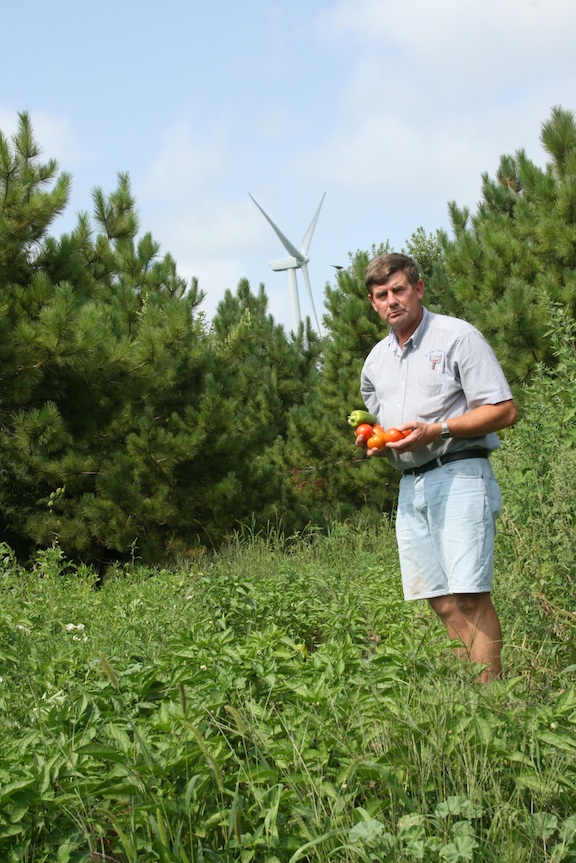 Gerry Meyer in his garden, turbine #4 in background
Gerry Meyer in his garden, turbine #4 in background
Wind Turbine Sounds Spur Health Complaints, Force Residents to Move
SOURCE: Acoustic Ecology Institute
The spread of wind turbines into quiet rural areas is leading to increasing complaints that they make more noise than residents were led to believe.
While simple annoyance and sleep disturbance are the most common effects, in some cases, nearby residents are reporting health problems that they associate with the presence of the turbines, leading some to move from their homes.
Not long after wind turbines began to spin in March near Gerry Meyer’s home in Wisconsin, his son Robert, 13, and wife, Cheryl, complained of headaches.
Cheryl also sometimes feels a fluttering in her chest, while Gerry is sometimes nauseated and hears crackling.
The nearest turbine is 1,560 feet from Meyer’s house. His dismay over an energy source he once thought was benign has made the retired mailman, 59, an activist. He travels the state warning communities considering wind farms to be wary.
“I don’t think anyone should have to put up with this,” says Meyer, who compares the sound to a helicopter or a jet taking off.
In Canada, Helen and Bill Fraser initially supported the nearby wind farm in Melancthon, Ont. One turbine sat close to the Fraser’s kitchen window. “We thought, more green energy, this is great,” Helen told CTV News. However, Helen says she developed headaches, body aches and she had trouble sleeping. The dog began wetting the floor at night.
“There were nights I was lying in bed and my heart would beat to the pulse of the turbine. It was an uneasy feeling,” Helen said.
Ernie Marshall at first supported the wind farm that was placed near his home near Goderich, Ont. However, he also says that once the turbines got rolling, his health began to suffer.
“I had problems with my heart, with my eyes, my digestive system,” Marshall told CTV News. “It traumatizes your whole body.”
Some affected residents can only sell their homes and move away. The Frasers left their home of 32 years and moved to nearby Shelburne, Ont. They say their symptoms have, for the most part, vanished.
Ernie Marshall moved to the town of Seaforth, Ont., which is several kilometers away from the turbines near his former home. “I had to get out or I wouldn’t be standing here talking to you,” Marshall said.
Dr. Nina Pierpont, a pediatrician in upstate New York, has interviewed dozens of people who live near windmills in Canada, the United States and Europe. Her [recently] released book, Wind Turbine Syndrome, documents the litany of health problems experienced by some people who have wind farms near their homes.
Some early findings suggest that wind turbines create a high intensity, low frequency sound that may have an effect on the body. Not only can the sound potentially cause debilitating illness.
Some researchers believe that the vibrations the sound causes in the inner ear may lead to vibro-acoustic disease, which can cause dizziness, nausea and sleep disturbances. However, officials with the Canadian Wind Energy Association point to a handful of studies they say prove that windmills lead to few, if any, adverse health effects.
“We know there have been complaints about health impacts of wind turbines,” Sean Whittaker of the Canadian Wind Energy Association told CTV News. “On the other hand, we know there are some 10,000 turbines installed across North America and complaints have been relatively few.”
The issue has not just put experts at odds. Communities across North America are divided between residents who say local windmills have made them sick and their neighbors who don’t believe them.
“Everyone was calling me a liar,” Ernie Marshall said. “It don’t matter who you talk to. You bring ‘em out here and they’ll say that noise don’t bother us. Sit there for a week under that and listen to it and see what it does to your body.”
The inconsistencies in the early research, coupled with the fact that some residents who live near wind turbines complain of such a wide array of symptoms, are evidence that further study is needed to determine if Wind Turbine Syndrome is a problem, how big of one and what should be done, experts say.
“Depending on your distance you’ll have 30, 40, 50 per cent of people who are troubled, but not 100 per cent,” Dr. Robert McMurtry of the University of Western Ontario told CTV News. “That’s why it’s important to do these studies to see just how many are troubled and how real it is.”
TORONTO INTERNATIONAL FILM FESTIVAL: WINDFALL
By Howard Feinstein
“Then I started to meet some people from Meredith. A lot of them—artists, writers—go up there to be alone. This topic pulled them out of their shells to work together.”
So began Israel’s foray into directing, Windfall, an excellent documentary–a real discovery in Toronto–which is as much a study of a small rural community torn asunder as it is of the pros and cons of the massive turbines which energy salesmen were pitching to the locals.
For a price, the residents could agree to let them build the massive structures on their land. In a town with no zoning, the reps from an energy outfit in Ireland anticipated huge profits.
Even though Delaware County is one of the five poorest in New York State, other towns were not as easily seduced as some of the homeowners in Meredith, who signed contracts for a relative pittance.
Most of those who agreed had been born there, former dairy farmers hard it by the economy and changes in agrarian commerce. Most of the opposition was comprised of former or current residents of New York City, whom the lifetimers, according to Israel, call “flatlanders.”
The feud became bitter, culminating in a new slate of candidates vying in a coming municipal election for the offices long held by lifers. The lines were drawn; the debate became more and more bitter.
“I don’t think it was like that before the subject came up,” says Israel. “There are no chi-chi boutiques there; it’s not that kind of town. It seemed like everyone got along. This subject pushed people into corners.” The lead-up to the election gives the film rhythmic, suspenseful momentum.
Israel interviews her subjects outdoors, capturing a natural, unforced bucolic backdrop enriched by a plucky, country-tinged score.
Most of them have interesting back stories that provide digressive texture. Stop-motion animator Dean Modino brings alive maps, photographs, and, building up over the course of the film’s running time, the wind turbines themselves, already cinematic by design.
As one relative newcomer to Meredith says, “These are not the 50’ windmills of Don Quixote. These are 400’ high.” Each blade is 130’ long, weighs seven tons, and moves at 150 miles per hour. The whishing noise is non-stop, and much worse when it rains.
The well-informed interviewees who stood against the turbines articulate their positions, as do several environmentalists and energy experts.
When erected too near peoples’ homes, the turbines wreak emotional and psychological havoc on the residents. Tug Hill, in Lowville, New York, is one place where 400 of them were built, and the townspeople have found them oppressive.
One subject says that to be built and maintained, they require fossil fuels, and it is questionable if the amount that they put back into the grid is worth the effort. Green and wind energy may be mutually exclusive terms.
Israel is the first to say she does not offer definitive answers. “I’m just asking people to look into it more. I know there’s a lot going on in Europe, even in Denmark. People there are asking if there really is that much power coming from the wind turbines.
“We want desperately to have easy answers. Then all you have to do is send in some money and someone else can take care of it.”
9/1/10 Sow the wind turbine, reap the crop damage AND...Wind Action Asks the hard Question: How compatible are wind farms and agriculture? AND Wind Turbines in the News AND A new understanding about wind turbine noise AND A letter from a participating wind project landowner from Columbia County to landowners in Brown County
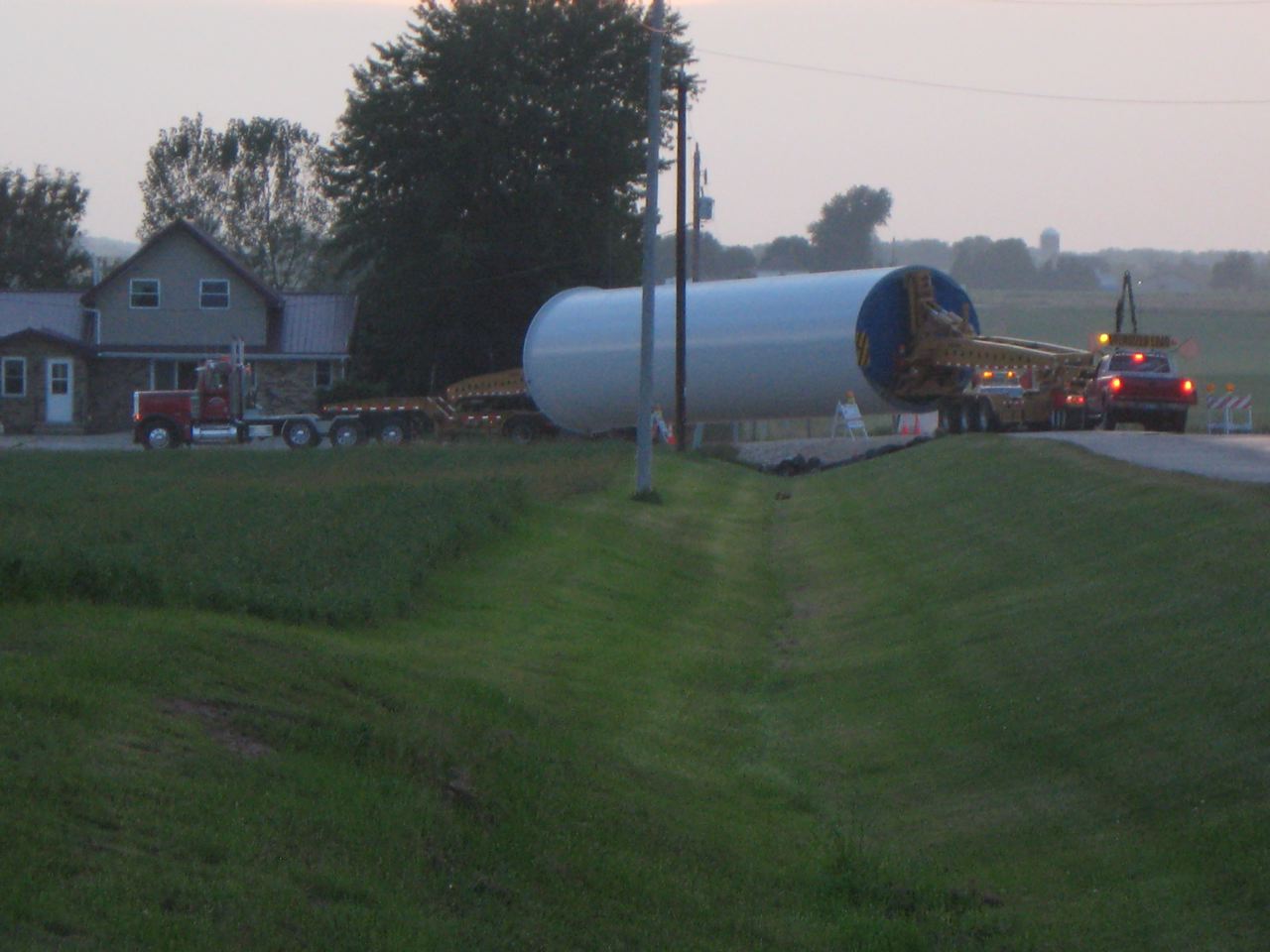
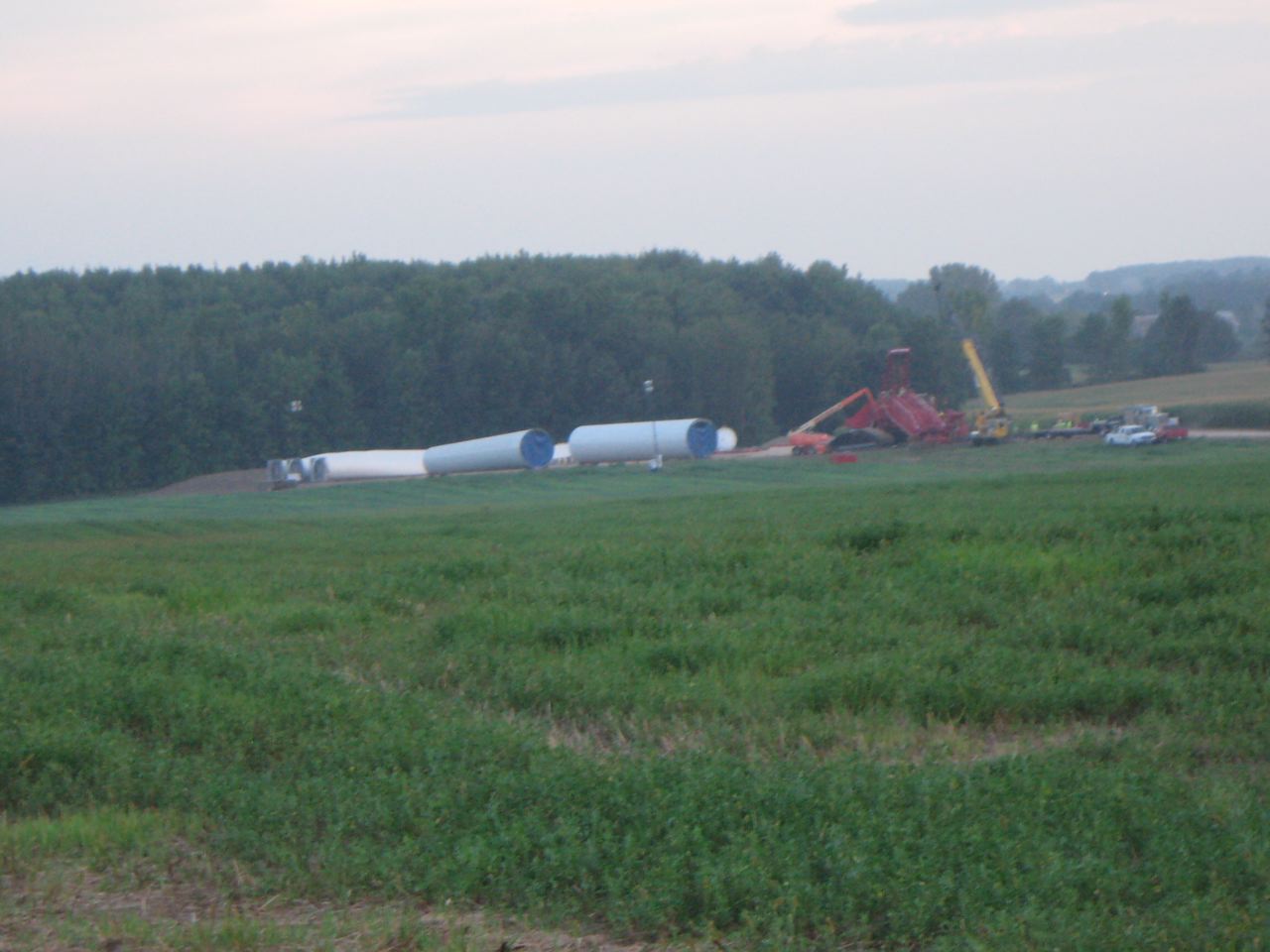 Construction begins on what will be the tallest wind turbines in the state. Town of Glenmore, Brown County Wisconsin. More photos throughout this post.
Construction begins on what will be the tallest wind turbines in the state. Town of Glenmore, Brown County Wisconsin. More photos throughout this post.
Below is A letter from a participating landowner in the Glacier Hills project which is under construction in Columbia County. He address it to Brown County landowners in an area where Invenergy wants to site a large project called "Ledge Wind"
SOURCE: PSC Docket # 9554-CE-100
To the landowners in the Ledge Wind Project:
If you believe wind turbines are a good fit for a farm operation, a free source of clean energy, and a benefit to your community, I invite you to come to the Glacier Hills Project and witness the total devastation occuring during construction.
Seeing firsthand what is happening here would turn any responsible landowner's stomach.
Heavy rains have created erosion that will take years to repair.
The number of huge construction equipment and trucks burning fuel is staggering.
Good productive farmland is being ripped apart, and will never be the same.
The level of disgust is even affecting the most loyal supporters of this project.
Hatred of this project is growing worse as each day passes, and we will be forced to live with this for the rest of our lives, all because a few irresponsible landowners, myself included, were taken in by wind developers lies.
All this for chump change.
Gary Steinich
Cambria, Wisconsin
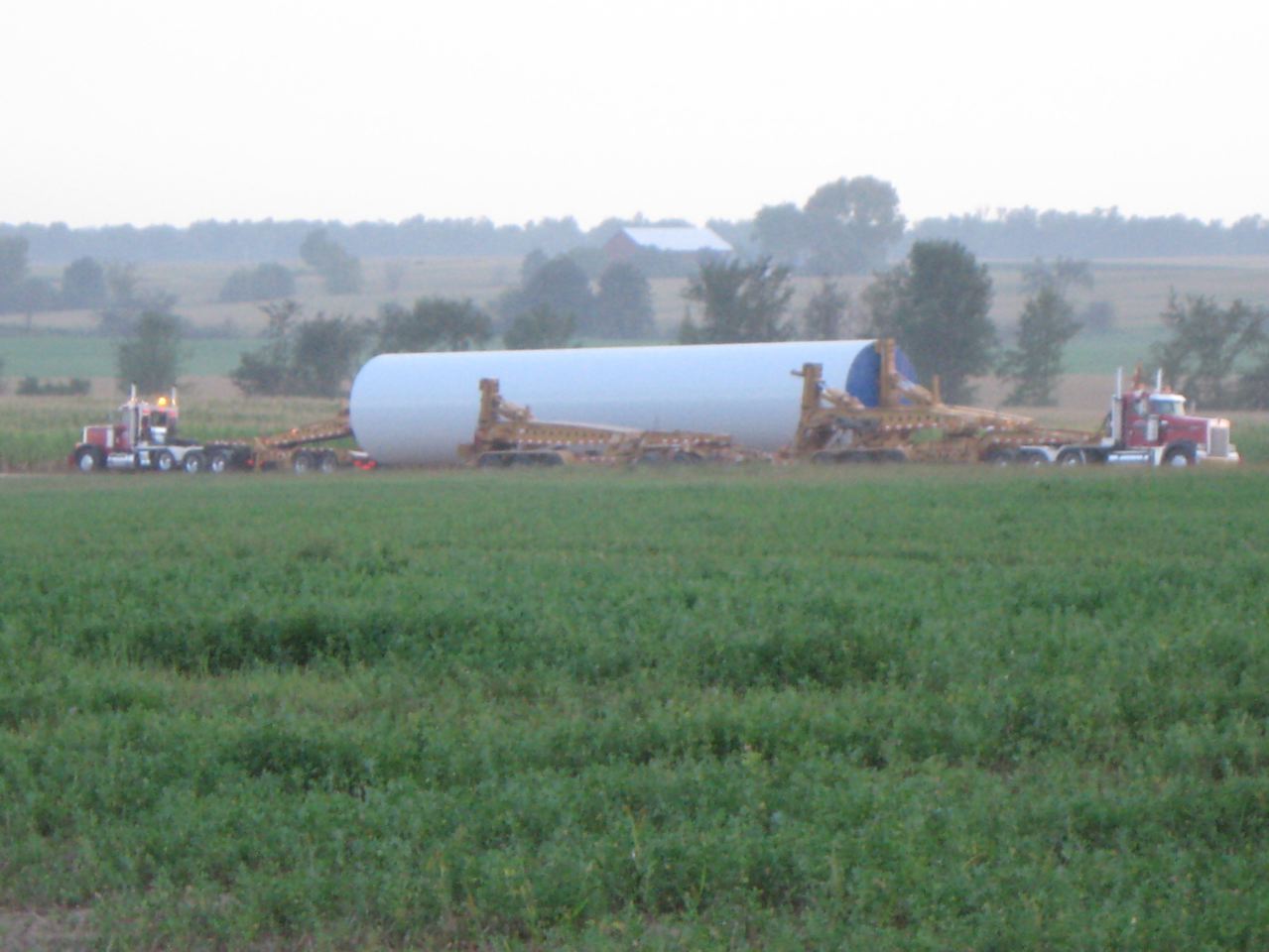
Is wind "farming" compatible with agriculture?
August 25, 2010
We're frequently reminded that wind energy and agriculture are compatible land uses. Farmers who lease sections of their crop land for wind development can continue working the soil right up to the towers and earn extra revenue for farming expenses. A win-win business opportunity, right? Not so fast. In this two-part series, Windaction.org examines the wind-farming relationship in the State of Illinois and tests the claim that the two are a good fit. As with so many topics involving wind energy, there is another story behind the story.
Back in 2007, Windaction.org posted a document entitled "What have I done?" The piece, written by Don Bangart of Chilton, Wisconsin, was based on a two- hour interview he conducted with a farmer in Northeast Fond du Lac County who agreed to lease a portion of his land for wind development. In the interview, the landowner makes several observations including this about how his land was managed:
"I watched stakes being driven in the fields and men using GPS monitors to place markers here and there. When the cats and graders started tearing 22 foot wide roads into my fields, the physical changes started to impact not only me and my family, but unfortunately, my dear friends and neighbors. Later, a 4 foot deep by 2 foot wide trench started diagonally across my field.
"A field already divided by their road was now being divided again by the cables running to a substation. It was now making one large field into 4 smaller, irregularly shaped plots. ...We soon realized that the company places roads and trenches where they will benefit the company most, not the land owner. ... All of the rocks we labored so hard to pick in our youth were replaced in a few hours by miles of roads packed hard with 10 inches of large breaker rock. Costly tiling we installed to improve drainage had now been cut into pieces by company trenching machines."
The Wisconsin farmer's experience is not unique.
Illinois has some of the best farming soil in the world with McLean County, Illinois rated #1 for the darkest, blackest most productive soil in the world.
But after extensive land moving and excavation needed to build roads and erect the turbines, farmers tell Windaction.org that the ground is never the same afterward. The fertile soil around the towers is mixed with subsurface clay and compacted resulting in lower crop yields. Depending on the lease terms, developers may compensate landowners for crop reductions but payments are often not passed on to tenant farmers who suffer the actual losses.
Since compaction is assumed to be a construction-related impact, crop-loss payments are often time-limited up to five years. However, every time turbines require maintenance, the massive crane is brought back to the site making compaction an ongoing concern throughout the life of the project. And it's not limited to existing roads or turbine pads. Turbine maintenance crews prefer to crawl across fields -- flattening crops and ground -- for quicker access to turbines needing service.
If drainage tiles are cut or damaged during construction, you're apt to see farmers working around ponds that were previously nonexistent. Or worse, adjacent fields not under lease can flood. With competition for rentable farmland so fierce, local tenant farmers risk losing their farms if they complain.
Soil compaction and drainage issues are serious concerns, but some might argue their effects are localized, and thus manageable. But that cannot be said about the impact of wind turbines on aerial spraying -- a subject that gets very little exposure.
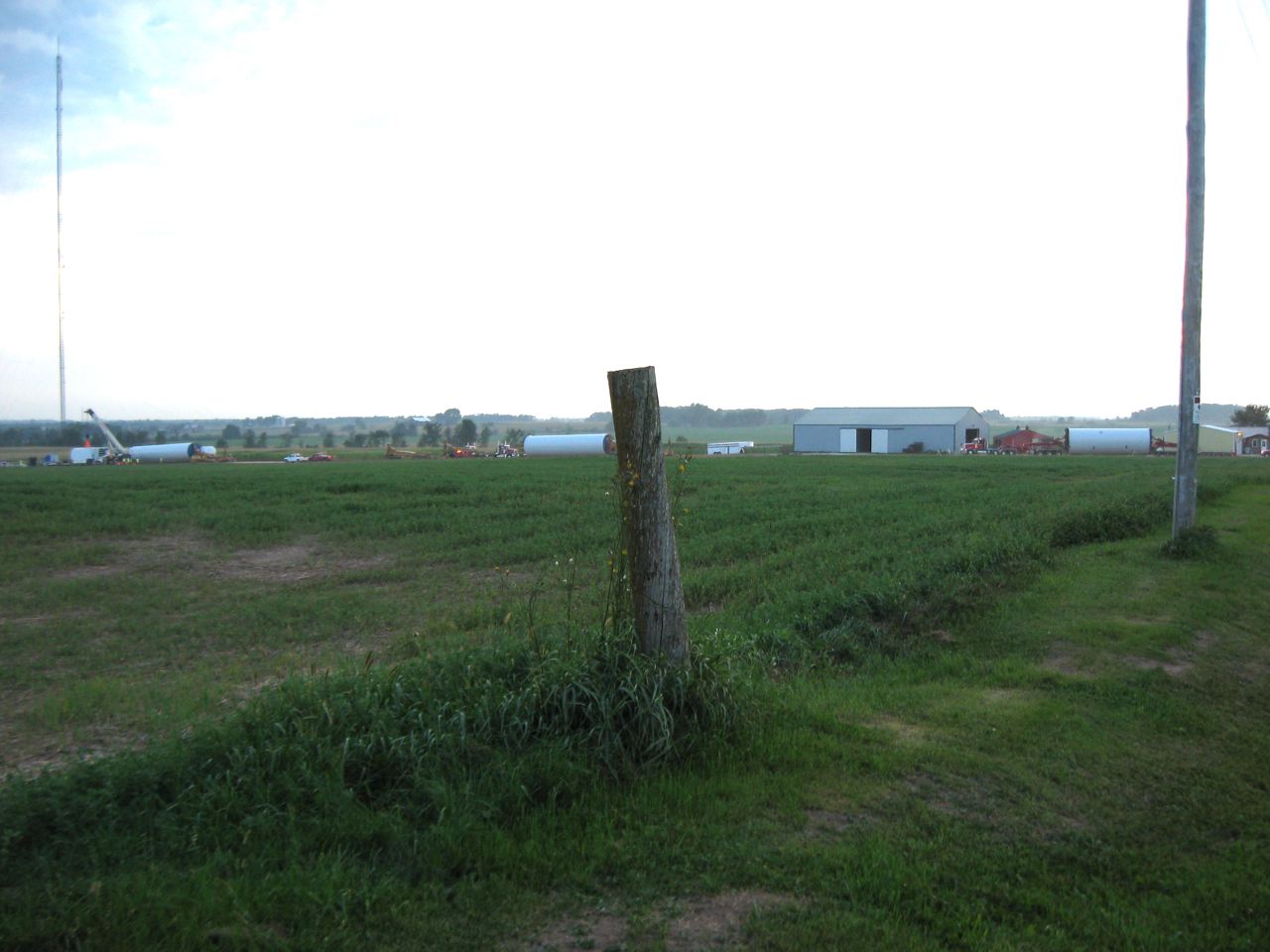
The ability to secure aerial spraying services is limited in areas where turbines are standing.
The message on the Illinois Agricultural Aviation Association (IAAA) website is clear:
"...farmers with wind generators may lose the option of aerial application of farm protection products, seed, fertilizers, etc. on their farm ground. Possibly more significant is that their neighbor farmers, who have no wind generator(s) and consequently no income from them, stand to lose that option as well.
"Some proponents of wind farms tend to dismiss this possibility out of hand, with the explanation that "those guys can fly around them with no problem," or "just get a helicopter to do it." Others say that ground application can still be effectively performed so the aerial option is insignificant. Unfortunately, it is just not that simple. Sometimes weather problems and/or timeliness of application dictate an application from the air.
"The fact is, it is dangerous to fly within the confines of a wind generator farm."
As more and more towers go up, less and less fields can be sprayed. Experienced pilots can feel the wake effect of the towers from several miles away. Such turbulence is dangerous to fly through.
Helicopters may be recommended because they travel at slower speeds and can work in more confined spaces but they can't carry the same loads meaning more trips at higher costs. There are far fewer helicopters in the State (under 10 in total) so timely availability is a critical issue.
Some farmers try ground applicators but aircraft can cover crops faster and more efficiently than any ground rig. In cases of Asian soybean rust, farmers could experience an 80-100% yield loss if not treated within a week. Aphids or spiders mites can destroy a field within days. If infestations occur during wet years ground equipment on wet soil will cause compaction or ruts that lead to erosion.
Illinois County Boards tasked with approving new wind development appear willing to accept that aerial applications are still possible but with more difficulty and at a higher cost (most spray policies charge premiums up to 50% above standard costs on fields within a mile of the towers, whether a participating landowner or not). What they do not seem to realize is that as more wind farms are permitted, the cumulative effect will lead to fewer and fewer fields that can be sprayed, making total crop loss a real possibility.
Since crop insurance will not cover the farmer in cases of insects or plant disease where damage is "due to insufficient or improper application of pest control measures or disease control measures", crop loss could lead to significant financial losses for farmers.
Illinois farm land has nearly 1900 megawatts of wind turbines installed across thousands of acres of farm land and thousands more slated for development. Absentee landowners may be gaining financially from the development, but the idea that "wind farming" is a compatible agriculture use is more myth than reality in Illinois.
Special thanks to Rick Reed, president of IAAA, who provided valuable information on aerial spraying.
Wind Turbines in the News
For the latest national and international wind news visit
News
GREEN PARTY OF CANADA CALLS FOR WIND TURBINE HEALTH STUDY:
Source: Green Party of Canada Website
Considerations:This motion, in calling for a study on the human health effects of wind turbines, would create a new policy and could potentially call into question some of the party's policies on significantly increasing the amount of energy produced through wind turbines.
Motion Preamble:WHEREAS the Green Party of Canada recognizes the vast potential for wind energy in Canada;
WHEREAS the Green Party of Canada with the Canadian Wind Energy Association has set goals for Canadian wind energy generation;
WHEREAS many citizens in communities with wind turbines claim to be experiencing sleep deprivation, headaches, and heart complications related to wind turbines;
WHEREAS one of the largest obstacles preventing accelerated wind energy development is resistance from citizens near planned turbine sites;
WHEREAS the largest investment Canadians make, their home, is affected as much by real health risks as perceived ones;
WHEREAS many provincial governments have compromised their objectivity with respect to wind energy development;
WHEREAS the Green Party of Canada considers healthy people and healthy communities as necessary for a strong Canada;
Motion Operative:THEREFORE BE IT RESOLVED that the Green Party of Canada seeks to have Health Canada initiate an epidemiological study on the human health effects of wind turbines in the interests of public health and safety.
Dong giving up on land-based turbines
Mass protests mean the
energy firm will look offshore
SOURCE: The Copenhagen Post Online
September 1, 2010
State-owned energy firm Dong Energy has given up building more wind farms on Danish land, following protests from residents complaining about the noise the turbines make.
It had been Dong and the government’s plan that 500 large turbines be built on land over the coming 10 years, as part of a large-scale national energy plan. This plan has hit a serious stumbling block, though, due to many protests, and the firm has now given up building any more wind farms on land.
SOURCE, ” On the Level: Quarterly Newsletter of the Vestibular Disorders Association (Summer 2010, p. 9)“Wind Turbines Can Affect Inner Ear Function,
Scientists have determined how infrasound from wind turbines may influence inner ear function.
An increasing number of people living near wind turbines report a group of symptoms termed “wind turbine syndrome” that include sleeplessness, dizziness, fatigue, ear pain and pressure, difficulty concentrating, and headache.
Up until now, many scientists who study hearing claimed that noise from wind turbines couldn’t be harmful because it occurred at a frequency too low for most people to hear.
Researchers at Washington University in St. Louis, Missouri successfully challenged this conventional wisdom that “what you can’t hear won’t hurt you.” They noted that one type of inner-ear sensory cell behaves differently when encountering infrasound.
Usually these cells respond to sound by contracting and expanding proteins within their walls, amplifying vibrations, which in turn stimulate other sensory cells to send electrical signals about sound to the brain. However, the proteins do not respond in the same way to infrasound and instead actively prevent stimulation of the cells that transmit sound signals.
So, while the brain may not receive information about sound, a physiological response to infrasound has occurred in both the cochlea and the other sensory structures in the inner ear such as the saccule, possibly explaining the unfamiliar sensations experienced by some people.
Reference:
Salt AN, Huller TE. “Responses of the ear to low frequency sounds, infrasound and wind turbines.” CLICK HERE TO DOWNLOAD Hearing Research 2010 Sep 1;268(1-2):12-21. Epub 2010 Jun 16.
8/19/10 PSC commissioners discuss wind siting rules.
At an open meeting held Thursday at the Public Service Commission of Wisconsin, commissioners discussed the the text of the proposed wind siting rule.
DOWNLOAD THE PROPOSED RULE BY CLICKING HERE
Commissioner Lauren Azar suggested a setback of 2200 feet from homes unless a developer can prove a turbine could be sited closer to a residence and still meet noise and shadow flicker standards.
She said the setback distance was based on information from PSC staff which indicated a 45dbA noise standard would be met at that distance.
However, Commissioner Azar also noted that the World Health Organization recommends 40 dbA as a nighttime noise standard, and indicated was the noise limit she preferred.
Residents under contract with developers could waive all standards and have turbines placed as close as 1.1 times the turbine height to their homes.
Chairman Callisto and Commissioner Meyer didn't offer their immediate opinions on Azar's suggestions.
Continued discussion of wind siting rules is scheduled for Monday.
8/7/10 Do bird and bat deaths matter to Big Wind?
NOTE FROM THE BPWI RESEARCH NERD: Why are more bats being killed in Wisconsin wind projects than anywhere else in the nation? Three recent post construction mortality studies show turbine related kill numbers in our state to be ten times the national average. They are even higher than those mentioned in the article below.
Bird, bat deaths prompt call for St. Lawrence Valley wind moratorium.
SOURCE North Country Public Radio, www.northcountrypublicradio.org
August 6 2010
Save the River, an environmental group based in Clayton, NY, wants a three-year delay in development of more wind power along the St. Lawrence River.
A spokesperson for the group says there are proposals for some 400 wind turbines in the Thousand Island region. Preliminary numbers from a study at an 86-turbine wind farm on Wolfe Island, a Canadian island near Kingston, Ontario, show higher than usual mortality among birds and bats. Martha Foley has more.
An environmental group is calling for a three-year moratorium on building more wind turbines in the St Lawrence Valley. Save The River points to recently released data indicating the 86-turbine wind farm on Wolfe Island caused more than a 1800 bird and bat deaths in six months.
The group’s assistant director Stephanie Weiss says that’s more than double the national average. “When we’re comparing these numbers, we’re talking about how many birds are dying in a 12-month period. The national average might be 2 or 3 or even as high as 4. But the numbers we’re seeing out of Wolfe Island are 8 birds per turbine, in a six-month period,” Weiss said.
Wolfe Island is Canadian territory. In Canada, the province decides where wind farms can be built. In New York State, it’s up to local town governments. Weiss says a moratorium would give them time to find out why avian mortality rates are so high on Wolfe Island. It’s the only wind farm on the St Lawrence River and it’s six months into a three-year study on bird and bat deaths caused by turbines.
“There are a lot of reasons why this could happen. Wolfe Island itself is an important bird area, designated by Nature Canada. It’s a part of the fly way, which is really important. We know there’s some really essential grassland habitat here. We know it’s incredibly important over-wintering raptor area,” said Weiss.
Weiss says once a wind farm is built, environmental damage is hard to undue. She says 400 wind turbines have been proposed in the Thousand Islands. And a thorough study at Wolfe Island will help local officials make the best decisions about if, and where, they should be built. “We can’t just guess at what kind of bird and bat mortality we would have. The three years are essential. I don’t think it’s too long. The wind will still be there,” Weiss said.

